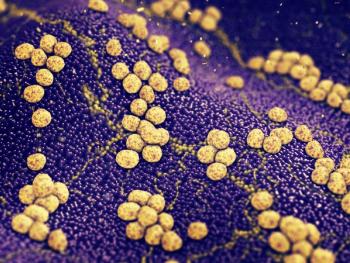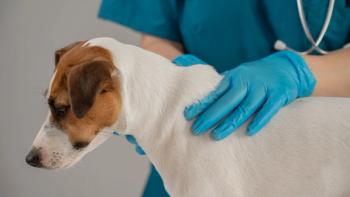
Performing skin surface cytology
Skin cytology can help identify bacterial or Malassezia infection, as well as characterize inflammatory infiltrate.
Skin cytology can be used to obtain information on bacterial or Malassezia infection, as well as to characterize inflammatory infiltrate.
Neutrophilic or pyogranulomatous inflammation can be supportive of an infectious or inflammatory process.
Pyogranulomatous inflammation due to deep pyoderma (100X).
An eosinophilic infiltrate can be supportive of a hypersensitivity or parasitic dermatitis, but can also be seen in other conditions, such as some drug reactions and feline herpesvirus dermatitis.
Eosinophilic inflammation found on an impression smear from a feline eosinophilic plaque (100X).
And acantholytic cells can suggest pemphigus complex (but can also be seen with chronic bacterial or dermatophyte infection) and support the need for biopsy and histologic examination.
Acantholytic cells and neutrophils in a case of canine pemphigus foliaceus (100X).
A skin cytology sample can be obtained in a variety of ways, depending on the type of lesion present. In general, apply samples to a microscope slide and stain with Diff-Quik or a similar stain. Then scan the sample at 4X to 10X magnification for a representative area, and examine that area under 40X to 100X magnification.
To sample a pustule, rupture it with a needle, and smear the contents onto a microscope slide. Pustule contents can be obtained by making an impression smear on a slide after rupturing the pustule with a needle. If needed, a squash preparation can be used on thick samples to achieve a more diagnostic monolayer of cells.
Cytologic evaluation of the pustule's contents reveals neutrophils and intracellular cocci (100X).
If a moist or greasy lesion or lichenified skin is present, firmly press a microscope slide onto the surface of the lesion to make an impression smear sample. Clinically, lichenification and hyperpigmentation are suggestive of Malassezia dermatitis, but can also be seen with chronic bacterial infection.
For dry scaling or diffuse crusting lesions, using a dulled scalpel blade without mineral oil can help collect surface debris. If larger crusts are present, use the blade or microscope slide edge to raise the edge of the crust, and then obtain an impression smear of the exudate or debris under the crust.
Smear the accumulated debris onto the microscope slide.
Cytologic analysis reveals streaming neutrophilic debris and bacterial cocci, but no Malassezia organisms are found (100X).
For interdigital lesions, obtain samples via direct impression by pressing the interdigital web onto a slide, swabbing the interdigital web with a cotton-tipped swab and spreading the debris onto a slide, or by making acetate tape impression. In cases of paronychia, collect nail bed debris with a dull blade or the wooden end of a cotton-tipped swab, then smear the debris onto a microscope slide. Here the interdigital web is firmly pressed onto the microscope slide.
Acetate tape impressions can be used to sample dry, lichenified, and interdigital areas. For a tape preparation, firmly and repeatedly press a piece of clear (not frosted) acetate tape to the lesion (lichenified skin seen here).
Then apply the sample onto a microscope slide over a few drops of blue Diff-Quik stain. Examine the sample under 40X to 100X magnification.
Cytologic analysis reveals keratinocytes with scattered neutrophils and cocci (100X).
<
In a different case, numerous Malassezia organisms are found on the tape prep (100X).
Newsletter
From exam room tips to practice management insights, get trusted veterinary news delivered straight to your inbox—subscribe to dvm360.




